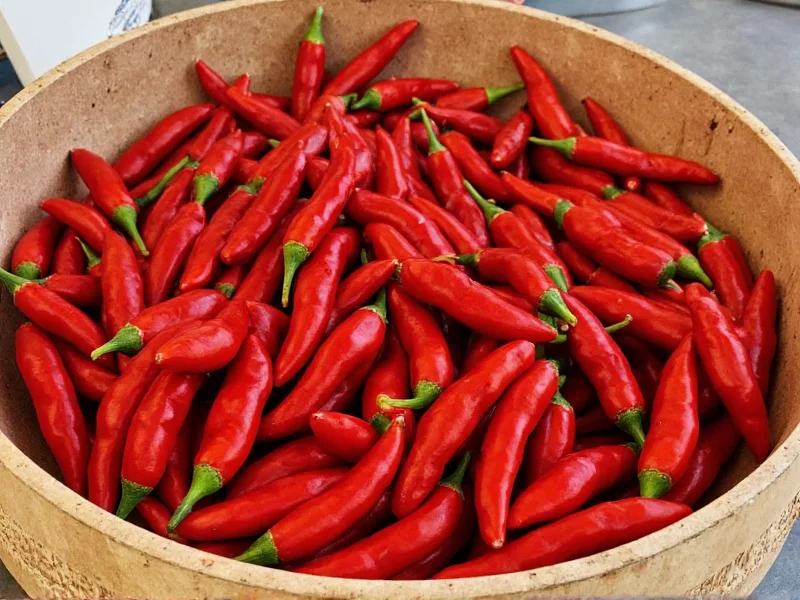Ancho chiles, the dried form of poblano peppers, offer a nuanced culinary experience that extends far beyond simple heat measurement. Understanding their spiciness requires examining both scientific measurements and practical cooking applications.
What Exactly Are Ancho Chiles?
Ancho chiles represent poblano peppers that have been harvested, dried, and aged. This transformation process develops complex flavor compounds while slightly reducing the fresh pepper's natural heat. The name "ancho" means "wide" in Spanish, referring to their broad, flattened shape after drying. These deep reddish-brown peppers feature a distinctive heart-shaped profile and wrinkled texture that signals proper drying.
Understanding Ancho Chile Heat Levels
The Scoville scale measures capsaicin concentration—the compound responsible for pepper heat. Ancho chiles consistently register between 1,000–2,000 SHU, placing them at the lower end of the heat spectrum:
| Pepper Type | Scoville Heat Units | Heat Comparison |
|---|---|---|
| Ancho Chile | 1,000–2,000 | Mild, approachable warmth |
| Jalapeño | 2,500–8,000 | 2–4x hotter than ancho |
| Serrano | 10,000–23,000 | 5–10x hotter than ancho |
| Habanero | 100,000–350,000 | 50–175x hotter than ancho |
This mild heat profile makes ancho chiles exceptionally versatile in Mexican and Southwestern cuisine. Unlike hotter varieties that dominate a dish with heat, anchos contribute subtle warmth while allowing their complex flavor notes to shine through.
Beyond Heat: The Flavor Profile of Ancho Chiles
Ancho chiles deliver a sophisticated flavor profile that explains their popularity despite modest heat levels:
- Fruity notes: Dried fruit characteristics reminiscent of raisins and figs
- Earthy undertones: Rich, soil-like notes that add depth to sauces
- Subtle sweetness: Natural sugars develop during the drying process
- Smoky complexity: Light smokiness from the sun-drying process
- Floral hints: Delicate floral notes that balance the earthiness
Chefs prize ancho chiles specifically because their mild heat allows these nuanced flavors to come through without overwhelming other ingredients. This makes them perfect for mole sauces, adobo marinades, and spice rubs where complexity matters more than intense heat.
Practical Cooking Applications
When incorporating ancho chiles into your cooking, consider these practical tips:
- Rehydration technique: Soak dried anchos in hot water for 15–20 minutes until pliable before blending into sauces
- Heat control: Remove seeds and membranes to further reduce already mild heat
- Flavor pairing: Complements chocolate, garlic, cumin, and oregano exceptionally well
- Texture consideration: Blend rehydrated peppers thoroughly for smooth sauces
- Storage tip: Keep dried anchos in airtight containers away from light for up to 6 months
Unlike hotter peppers where heat often overshadows other flavors, ancho chiles provide the foundational flavor in many traditional Mexican dishes precisely because their mild heat allows other ingredients to shine. This characteristic makes them ideal for introducing people to Mexican cuisine who might be intimidated by spicier varieties.
Common Misconceptions About Ancho Chile Heat
Several misconceptions persist about ancho chile spiciness:
- Myth: All dried chiles are significantly hotter than fresh peppers Reality: Drying concentrates flavors but doesn't necessarily increase heat; anchos are milder than fresh jalapeños
- Myth: Ancho chiles are interchangeable with guajillo peppers Reality: While both are mild, guajillos (2,500–5,000 SHU) are noticeably hotter than anchos
- Myth: Darker chiles are always hotter Reality: Color indicates maturity and drying time, not heat level; anchos darken as they dry but remain mild
Why Ancho Chiles' Mild Heat Matters in Culinary Applications
The moderate spiciness of ancho chiles serves specific culinary purposes that hotter peppers cannot fulfill. Their heat level allows for generous use in sauces and stews without making dishes uncomfortably spicy, while still providing that essential pepper warmth that enhances other flavors. This balance explains why professional chefs consistently choose anchos as the base for complex sauces like mole poblano, where multiple chile varieties combine but none should dominate.
When substituting ancho chiles in recipes, understanding their mild heat profile is crucial. Replacing them with significantly hotter peppers like chipotles (2,500–10,000 SHU) would dramatically alter a dish's flavor balance. Conversely, using anchos in recipes designed for hotter peppers creates a milder, more approachable version suitable for broader palates.
How spicy are ancho chiles compared to jalapeños?
Ancho chiles are significantly milder than jalapeños. Anchos measure 1,000–2,000 Scoville units while jalapeños range from 2,500–8,000 units, making jalapeños approximately 2–4 times hotter. This difference means you can use more ancho chiles in recipes without overwhelming heat.
Can children eat dishes made with ancho chiles?
Yes, dishes made with ancho chiles are generally suitable for children because of their mild heat level (1,000–2,000 SHU). Many traditional Mexican dishes using anchos, like mole poblano, are family-friendly. For extremely sensitive palates, removing seeds and membranes further reduces the minimal heat.
Do ancho chiles get hotter when cooked?
No, ancho chiles don't become hotter when cooked. Their mild heat level (1,000–2,000 SHU) remains consistent during cooking, though heat distribution may make the spice feel more pronounced. Long cooking times can actually mellow their heat slightly while enhancing their complex flavor profile.
How does ancho chile heat compare to other dried peppers?
Ancho chiles (1,000–2,000 SHU) are milder than guajillo (2,500–5,000 SHU) and chipotle (2,500–10,000 SHU) peppers but hotter than pasilla (1,000–2,500 SHU). They occupy the lower-mid range of dried pepper heat, making them versatile for dishes requiring subtle warmth without overwhelming spice.
Why do some ancho chiles seem spicier than others?
Natural variation in pepper heat occurs due to growing conditions, soil composition, and water availability. While anchos consistently fall in the 1,000–2,000 SHU range, individual peppers may vary. Seeds and membranes contain most capsaicin, so peppers with more intact internal structures will taste spicier than those with seeds removed.











 浙公网安备
33010002000092号
浙公网安备
33010002000092号 浙B2-20120091-4
浙B2-20120091-4